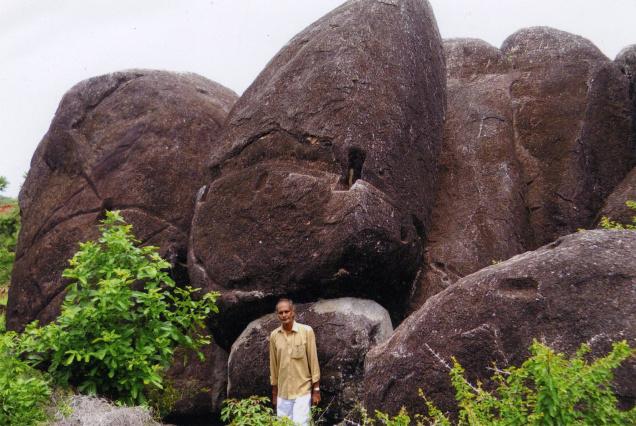
The cluster of unique oval-shaped standing rock formations each measuring about eight metres in height and 28 metres in circumference and having well-defined ledge cuts and postholes used for wooden canopy like shelter, could have been a habitation and a place of worship. That a prehistoric circular hut existed here is indicated by circular postholes found on boulders opposite to the cluster of standing rocks within a radius of 3.05 metres.
Quite surprisingly, the rocks are well protected as the place continues to be revered as 'Pandavulapancha,' 'Pandavuladoddi' and 'Demudurallu' (stones of God) in the local legend, the belief being Pandavas lived in the rock shelter for some time during their 'aranyavasa' and the place belongs to God.
Pandavulapancha, the name given to a naturally formed cavern containing five rock beds is located on the rear side. These beds are hewn on the large inclined rock aligned in the north-south direction, another proof of prehistoric people living there. The cavern was later occupied by Jain ascetics by making some alterations to the beds and chiselling channels around the bed enabling free flow of rain water.
Similar common inclined rock-cut beds are found in the Jaina caves at Udayagiri and Khandagiri near Bhubaneshwar in Odisha. Mr. Rao cites this as strong evidence of Jainism entering into ancient "Andhradesa" from Magadha, Kalinga into Madhyama Kalinga region and the present day Amudalavalasa mandal in Srikakulam district, 280 km from Jaina caves in Udayagiri.
Mr. Rao, however, compares the cluster with druidical rocks put together by druids, the ancient class of priests. Swearing by the solar cult, they worshipped standing stones found all through Britain and some archaeologists believe druids might have built the world-famous prehistoric Stonehenge monument. Similarly, worshipping of standing stones was an ancient form found in India and Chittivalsa rocks could be counted among them.
Interestingly Mr. Rao also found rare brushing marks of Sivalinga in the eastern rocks of the site that is spread over five acres. These marks are similar to those found by Bruce Foote, European archaeologist, in Kappagallu Hill in Bellary district of Karnataka. "This indicates that people worshipped Siva between prehistoric period and the entry of Jainas to the place," he added.



Reader Comments
to our Newsletter